Pronunciation /ˌtɛtrəˈsaɪkliːn/ AHFS/Drugs.com Monograph License data US FDA: Tetracycline Molar mass 444.435 g/mol Bioavailability 75% | Trade names Sumycin, others MedlinePlus a682098 Formula C22H24N2O8 CAS ID 60-54-8 Soluble in Alcohol, Alkali hydroxide | |
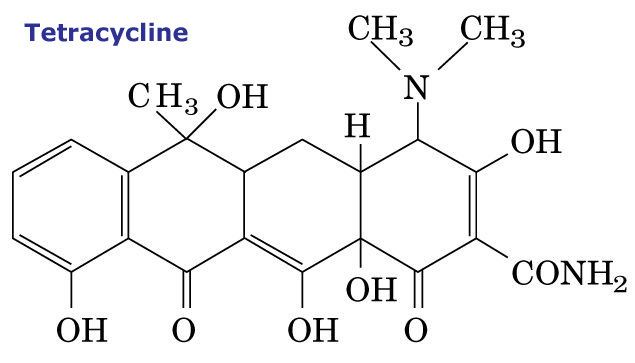 | ||
Pregnancy
category AU: D
US: D (Evidence of risk) IUPAC ID (4S,6S,12aS)-4-(dimethylamino)-1,4,4a,5,5a,6,11,12a-octahydro-3,6,10,12,12a-pentahydroxy-6-methyl-1,11-dioxonaphthacene-2-carboxamide | ||
Tetracycline
Tetracycline, sold under the brand name Sumycin among others, is an antibiotic used to treat a number of infections. This includes acne, cholera, brucellosis, plague, malaria, and syphilis. It is taken by mouth.
Contents
- Tetracycline
- Tetracycline antibiotics
- Medical uses
- Spectrum of bacterial susceptibility
- Mechanisms of resistance
- Side effects
- Other uses
- Cell culture
- Mechanism of action
- History
- Evidence in antiquity
- Price
- Names
- References
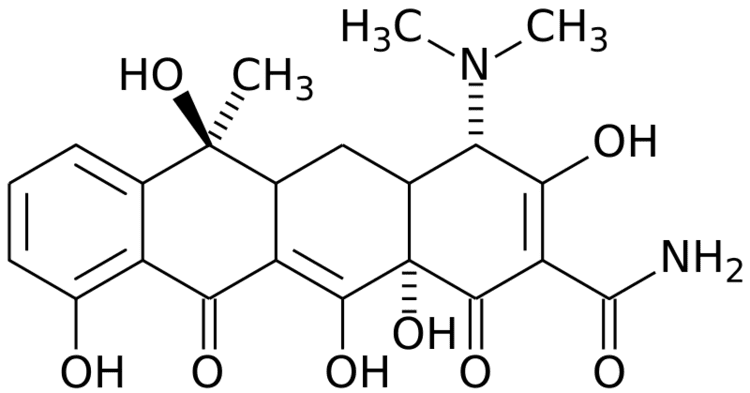
Common side effects include vomiting, diarrhea, rash, and loss of appetite. Other side effects include poor tooth development if used by children less than eight years of age, kidney problems, and sunburning easily. Use during pregnancy may harm the baby. Tetracycline is in the tetracyclines family of medications. It works by blocking the bacteria's ability to make protein.
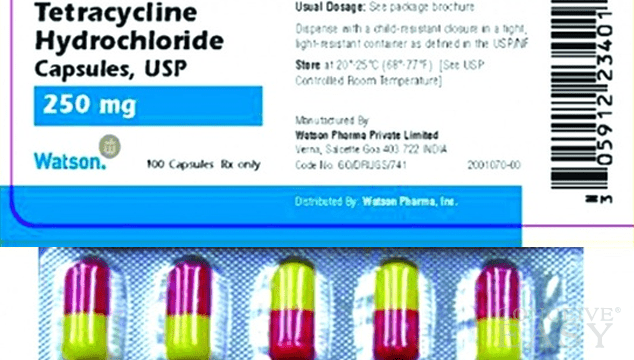
Tetracycline was patented in 1953 and came into commercial use in 1978. It is on the World Health Organization's List of Essential Medicines, the most effective and safe medicines needed in a health system. Tetracycline is available as a generic medication. The wholesale cost in the developing world is about 0.35 to 1.78 USD for a course of treatment. In the United States a course of treatment typically costs less than 25 USD. Tetracycline was originally made from the bacteria Streptomyces.
Tetracycline antibiotics
Medical uses
It is first-line therapy for rocky mountain spotted fever (Rickettsia), Lyme disease (B. burgdorferi), Q fever (Coxiella), psittacosis and lymphogranuloma venereum (Chlamydia), mycoplasma pneumoniae and to eradicate nasal carriage of meningococci. Tetracycline tablets were used in the plague outbreak in India in 1994.
Spectrum of bacterial susceptibility
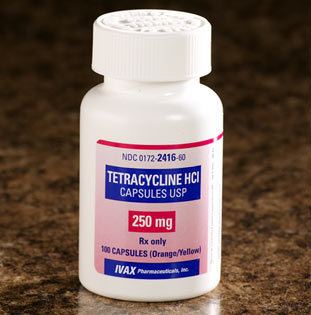
Tetracyclines have a broad spectrum of antibiotic action. Originally, they possessed some level of bacteriostatic activity against almost all medically relevant aerobic and anaerobic bacterial genera, both Gram-positive and Gram-negative, with a few exceptions, such as Pseudomonas aeruginosa and Proteus spp., which display intrinsic resistance. However, acquired (as opposed to inherent) resistance has proliferated in many pathogenic organisms and greatly eroded the formerly vast versatility of this group of antibiotics. Resistance amongst Staphylococcus spp., Streptococcus spp., Neisseria gonorrhoeae, anaerobes, members of the Enterobacteriaceae and several other previously sensitive organisms is now quite common. Tetracyclines remain especially useful in the management of infections by certain obligately intracellular bacterial pathogens such as Chlamydia, Mycoplasma and Rickettsia. They are also of value in spirochaetal infections, such as syphilis, leptospirosis and Lyme disease. Certain rare or exotic infections, including anthrax, plague and brucellosis, are also susceptible to tetracyclines. These agents also have activity against certain eukaryotic parasites, including those responsible for diseases such as malaria and balantidiasis. The following represents MIC susceptibility data for a few medically significant microorganisms:
Mechanisms of resistance
Bacteria usually acquire resistance to tetracycline from horizontal transfer of a gene that either encodes an efflux pump or a ribosomal protection protein. Efflux pumps actively eject tetracycline from the cell, preventing the buildup of an inhibitory concentration of tetracycline in the cytoplasm. Ribosomal protection proteins interact with the ribosome and dislodge tetracycline from the ribosome, allowing for translation to continue.
Side effects
Use of the tetracycline antibiotics group is problematic; they can:

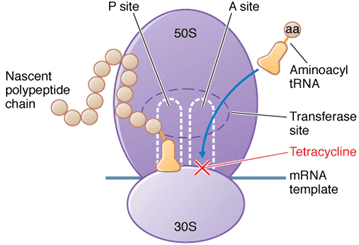
Caution should be exercised in long-term use with breastfeeding. Short-term use is safe; bioavailability in milk is low to nil. According to the U.S. FDA, there are case reports of Stevens–Johnson syndrome, toxic epidermal necrolysis and erythema multiforme associated with doxycyline use but a causative role has not been established.
Other uses

Since tetracycline is absorbed into bone, it is used as a marker of bone growth for biopsies in humans. Tetracycline labeling is used to determine the amount of bone growth within a certain period of time, usually a period of approximately 21 days. Tetracycline is incorporated into mineralizing bone and can be detected by its fluorescence. In "double tetracycline labeling", a second dose is given 11–14 days after the first dose, and the amount of bone formed during that interval can be calculated by measuring the distance between the two fluorescent labels.
Tetracycline is also used as a biomarker in wildlife to detect consumption of medicine- or vaccine-containing baits.
In genetic engineering, tetracycline is used in transcriptional activation. It is also one of a group of antibiotics which together may be used to treat peptic ulcers caused by bacterial infections. In cancer research at Harvard Medical School, tetracycline has been used to switch off leukemia in genetically altered mice, and to do so reliably, when added to their drinking water. The mechanism of action for the antibacterial effect of tetracyclines relies on disrupting protein translation in bacteria, thereby damaging the ability of microbes to grow and repair; however protein translation is also disrupted in eukaryotic mitochondria leading to effects that may confound experimental results.
A technique being developed for the control of the mosquito species Aedes aegypti uses a strain that is genetically modified to require tetracycline to develop beyond the larval stage. Modified males raised in a laboratory will develop normally as they are supplied with this chemical and can be released into the wild. Their subsequent offspring will inherit this trait, but will find no tetracycline in their environment and so will never develop into adults.
Cell culture
Tetracycline is used in cell biology as a selective agent in cell culture systems. It is toxic to prokaryotic and eukaryotic cells and selects for cells harboring the bacterial tet r gene, which encodes a 399-amino-acid, membrane-associated protein. This protein actively exports tetracycline from the cell, rendering cells harboring this gene more resistant to the drug. The yellow crystalline powder can be dissolved in water or ethanol and diluted to its final concentration in cell culture, where it has a half-life of approximately 24 hours.
Mechanism of action
Tetracycline inhibits protein synthesis by blocking the attachment of charged aminoacyl-tRNA to the A site on the ribosome. Tetracycline binds to the 30S subunit of microbial ribosomes. Thus, it prevents introduction of new amino acids to the nascent peptide chain. The action is usually inhibitory and reversible upon withdrawal of the drug. Mammalian cells are less vulnerable to the effect of tetracyclines, despite the fact that tetracycline binds to the small ribosomal subunit of both prokaryotes and eukaryotes (30S and 40S respectively). This is because bacteria actively pump tetracycline into their cytoplasm, even against a concentration gradient, whereas mammalian cells do not. This accounts for the relatively small off-site effect of tetracycline on human cells.
History
The tetracyclines, a large family of antibiotics, were discovered as natural products by Benjamin Minge Duggar in 1945 and first prescribed in 1948. Benjamin Duggar, working under Yellapragada Subbarow at Lederle Laboratories, discovered the first tetracycline antibiotic, chlortetracycline (Aureomycin), in 1945.
In 1950, Harvard University professor R.B. Woodward determined the chemical structure of the related substance, oxytetracycline (Terramycin); the patent protection for its fermentation and production was also first issued in that year. Chemist Lloyd Conover, in a research team of eight scientists at Pfizer, collaborated with Woodward over a two-year period, leading to tetracycline's discovery.
Pfizer was of the view that it deserved the right to a patent on tetracycline and filed its Conover application in October 1952. Cyanamid filed its Boothe-Morton application for similar rights in March 1953, while Heyden Chemicals filed its Minieri application in September 1953, named after scientist P. Paul Minieri, to obtain a patent on tetracycline and its fermentation process. This resulted in tetracycline litigation in which the winner would have to prove beyond reasonable doubt of priority invention and tetracycline’s natural state.
Evidence in antiquity
Nubian mummies studied in the 1990s were found to contain significant levels of tetracycline; the beer brewed at the time was conjectured to have been the source.
Price
According to data from EvaluatePharma and published in the Boston Globe, the price of tetracycline rose from $0.06 per 250 miligram pill in 2013 to $4.06 a pill in 2015. The Globe described the "big price hikes of some generic drugs" as a "relatively new phenomenon" which has left most pharmacists "grappling" with large upswings" in the "costs of generics, with 'overnight' price changes sometimes exceeding 1,000 percent."
Names
It is marketed under the brand names Sumycin, Tetracyn, Lymecycline, and Panmycin, among others. Actisite is a thread-like fiber formulation used in dental applications.
It is also used to produce several semisynthetic derivatives, which together are known as the tetracycline antibiotics. The term "tetracycline" is also used to denote the four-ring system of this compound; "tetracyclines" are related substances that contain the same four-ring system.
